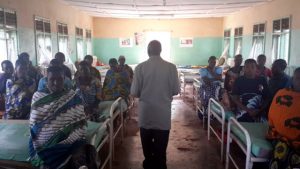
Educating women in the maternity home at Kibondo Hospital
This a series of first-person anecdotes from Vital Strategies Community Health Workers (CHWs) working on the ground to improve maternal health in Tanzania. Women in Tanzania face a 1 in 38 risk of dying from complications during pregnancy and childbirth; these advocates work every day to improve much-needed maternal care for Tanzanians, disseminating important health information and encouraging expectant mothers to access services at rural health centres.
CHW Name: Maria Na Ezekiel
Reporting from: Buhingu Dispensary
Successes you’ve encountered:
While was in Buhingu Village visiting pregnant women, I met with a pregnant woman who was 6 months pregnant. She [had] not yet started attending the clinic. She had swollen legs, a strong fever, and bleeding in her reproductive organs. I observed these symptoms to be dangerous. I counseled her to go to the hospital. She asked me to escort her, which I did the next day. She met with the doctor; got treatment and proper consultation. She thanked me for education [on the issue]. This pregnancy was her ninth; she had never given birth in the hospital before. After understanding [the issues], she is now ready to deliver in the hospital.
CHW Name: Ramadhani Shabani
Reporting from: Nguruka Health Center
Challenges you’ve recently faced:
It’s dangerous behavior to keep a pregnant woman inside until the last minute. My sister-in-law was pregnant. She attended clinic until she was about to deliver. [Then], her husband took her to a traditional mid-wife nurse. By 10:00 AM she delivered; unfortunately a baby came out with the mother’s placenta. That incidence caused the mother to enter an unconscious state. At last the child was successfully removed from the placenta by 4 PM in the evening. Her husband told me; I took my friend’s car and rushed them to the health center. We found a nurse there who in less than 10 minutes removed that placenta successfully. I had to make appointments with pregnant women, before and after meeting with them. I had to follow up to see whether they understood what I taught them – [and if] they have shared [that knowledge] with their families and husbands. Some did, some didn’t. Some women disappointed me, not turning [up] at the training ground as we agreed. Much more effort needs to be applied to overcome this challenge.
Successes you’ve encountered:
Another incident happened to a certain woman who stays in Nguruka Village. She got pregnant and attended the clinic for all 9 months. When the time to deliver arrived, she went to the health center and got admitted. The placenta broke as usual, but the child could not come out easily. The nurse by the name of Anna consulted Doctor Chamgeni who helped her with no success. After thoroughly observation she was [given an] ultrasound for swelling. The swelling resulted from eating ‘pemba’ (a special soil made for pregnant women). This soil turned into solid waste which prevented a child from coming out. Doctor Chamgeni pressed hard the soil came out like waste, and then a child came out. What would have happened if the woman decided to give birth at home?! I started my work in September 2014 after being trained. I volunteered until October first, 2014 when I was officially recruited. 180 women gave birth during that month. This is a big difference from the past 4 four months! Previously delivery in health centers [had monthly] averages of 50, 90, and 100 [births]. [In those months], 10, 8, and 5 births were by operation. After I trained the [women], birth by operations dropped to only 4 women. They knew the importance of attending the health center early, before the critical moment. 143 gave birth in November and only 3 were by operation.